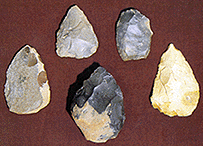 The tool technology of the Neanderthals was called the Mousterian industry. This was a technology that allowed for greater amount of flakes per core rock. It showed a technology that had a prepared or desired core shape. The flint cores were trimmed around the edges giving a disk-like shape. The flakes that were produced were retouched and made into scrapers, points and knives. These tools were used for specialized tasks such as skin and meat preparation, hunting and woodworking.
The tool technology of the Neanderthals was called the Mousterian industry. This was a technology that allowed for greater amount of flakes per core rock. It showed a technology that had a prepared or desired core shape. The flint cores were trimmed around the edges giving a disk-like shape. The flakes that were produced were retouched and made into scrapers, points and knives. These tools were used for specialized tasks such as skin and meat preparation, hunting and woodworking.
They lived in both caves and open hut-like shelters. Evidence of an open shelter was found at a site called Moldova in Ukraine. Here an oval ring measuring 26 by 16 feet, made of mammoth bones was found and inside were the remains of two hearths. Neanderthals were successful hunters as seen by the huge amount of mammoth bones found at Neanderthal sites. They also gathered as well, eating berries, nuts, fruits and vegetables. They most likely wore clothing made of animal skins. Scholars investigation of the fossilized vocal tracts have suggested that since they are virtually identical to those of modern humans, that Neanderthals were capable of articulating speech with a large variety of sounds.
There has also been evidence found at a few sites of deliberate burial. At La Chappelle and at Shanidar for example bodies are deliberately placed in a position with tools, animal bones, flower arrangements and sometimes a stone slab to cover the body. At Atapuecca Spain a disposal of bodies was done. Here 29 bodies were thrown into a long shaft at the back of the cave. The known burial sites through out Europe and Central Asia are, La Chappelle, La Ferassie, Tabun, Amud, Kebara, Shanidar and Teshik-Tash.